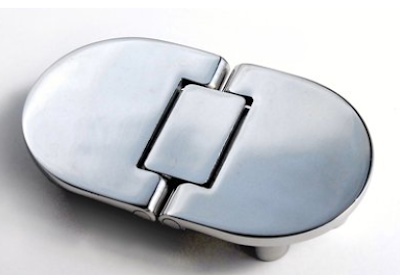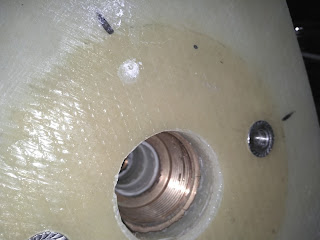A lot of people have their own ways of installing seacocks in the hull of a boat. The previous owner of Third Wave did what many used to do years ago which was to connect the seacocks to through hull fittings as shown below.
While it was widespread practice at the time, we now know that seacocks
and through hulls are the number 1 cause of boats sinking at the dock. This is not something you just recover from. The boat must be gutted, all new electronics, all new wiring, all new engines, etc. It's basically a total loss.
When something like this is at stake, there is no such thing as "overkill" in an implementation IMO. This became such an issue that ABYC came up with a standard that says a seacock must withstand 500 lbs of force to the inboard portion of the unit for 30 seconds without water ingress. This link shows what 500 lbs of lateral force does to this Forespar Marelon seacock. While the seacock didn't fail, it very likely allowed water to intrude due to deflection. It was this video that made me decide to come up with my own mechanism for installing seacocks so that they would easily be able to pass ABYC lateral load tests and without any deflection or damage to the unit.
In most cases I used 1/2" G10 pultruded fiberglass, 1/2" thick but in the example shown here, the backing plate material never showed up in time so we laminated a few pre-made 1/4" thick glass and poly sheets together to make the basic backing plate. Below you see the plate with 3 of the stainless bolts and crown nuts already installed. This blog post shows the process used to install the the 4th and final nut and bolt. Here is the top with 1 bolt still needing to be installed.
And here is the bottom.
The position of these nuts is critical, especially when dealing with stainless nuts and bolts like we are doing. If they are off just a little bit, the stainless will gall and then you will have to cut it out and start over. So there is no such thing as being "close enough" here. It must be exact. And you cannot be exact by eye. So you cannot just set the seacock on the backing material and then mark the holes like you were doing a wood working project. The first nut installation is the easiest because it is the base for all the other nut placements but after that you have to follow a process which guarantees mechanical alignment. That is why there are so many steps below. The same process is followed for nuts 2, 3 and 4. Below I will show the sequence just for nut and bolt number 4 (because Perko seacocks have 4 installation holes).
The first step is to find the exact center of the hole you are working on. Given that this post covers the last hole, the other 3 holes already being done, just bolt the seacock to the backing plate with the 3 nuts and bolts that are already installed. Then, from the top, take a drill that is the same diameter as the seacock hole and drill in about 1/4". DO NOT drill all the way through yet! All you are doing is finding the exact center of the hole right now.
After that's done, that a small drill, like 1/16" and place it in the center of the depression that you just created and then drill straight down through. Many people cock the drill at an angle without knowing it and if you are prone to do this, use a square to make sure you are straight up and down.
Now flip the plate over and you will see the small hole you just created.
Now you need to find two forstner bits for your drill and this is based on the size of your crown nut. The first drill is the larger of the two and that creates an inset ledge for the crown nut. The second creates a void for the body of the nut.
Starting with the larger of the two bits and drilling from the bottom of the plate...
... you create a small disc like cutout for the crown of the nut as shown below.
You know you have gone deep enough when you can hide the crown in the depression as shown below. It pays to go slow in this process until you have measured like this a few times and get a feeling for it.
Now you use the smaller forstner bit to create a void where the body of the nut will be pressed into. It is key that you drill just the right depth here. The easy way to measure this is to hold the crown nut up to the drill bit and see where the top of the nut lands on the drill if the base of the crown is held next to the cutting teeth of the forstner bit. By the way, Harbor Freight sells a very low cost forstner bit set that has both of the bits I needed to do this job (which uses 3/8-24 crown nuts and 1-1/4" long 3/8-24 stainless bolts).
df
This second bit is then used to cut a concentric void within the first larger diameter cut.
Here is what it looks like when done with the forstner bits:
Now flip the plate back over and install any bolts for which embedded nuts are already present and then go ahead and carefully drill straight down from the top all the way through to the other side.
Once this is done, remove all the existing bolts and then place the crown nut body up into the hole from the bottom and use the nut and a flat washer on top to screw it up into place. The smaller forstner bit will have drilled a cavity that is a bit too small for the nut but as you wrench it up into position, the corners of the nut will dig into the glass material and displace it so that the nut becomes press fit into the glass. I found that using fine threat bolts made this process smooth and easy because more turns to do the same work means more force is applied per turn. It's like using a lower gear and it makes the press fit operation very easy.

Once this is done, all 4 nuts will have been perfectly placed, so perfect that you can screw the seacock down to the plate by hand. You know that stainless galling is a threat if you have to use any real force at all getting the bolts to cinch down. It means you have misalignment between the 4 nuts. If this happens then you are at risk of having to start over. Note that the use of anti-sieze compound like this is recommended for stainless nuts and bolts, especially where they will be torqued down pretty hard.
The finished backing plate as viewed from its underside is shown below.
The hull is then roughed up in the region of installation with a grinder or a rotary tool with a flapper sanding pad (these work well with my Makita polisher...) and then the base plate is glued to the hull with 5200. The plate is held fast to the inside of the hull by screwing the straight threaded mushroom intake piece tightly up into the seacock while the seacock is bolted to the base (this step is not shown). After the 5200 cures, the mushroom pickup is unscrewed and the seacock is unbolted from the base backing block and the 5200 is holding it all in place securely.
The base block is then glassed securely to the hull as shown below. When the glass is cured, just bolt the seacock down and reinstall the intake mushroom from below (with sealant of course) and you are good to go. This is massive overkill for sure but it will be nearly indestructible. Also, with this setup you can change the seacock out pretty easily even while in the water. Just have a diver place a larger styrofoam cup over the mushroom intake, and then in 2 minutes you can unbolt the seacock from the bilge side and spin it off the mushroom intake. Then spin a new seacock back on, bolt it down and you are good to go.





































